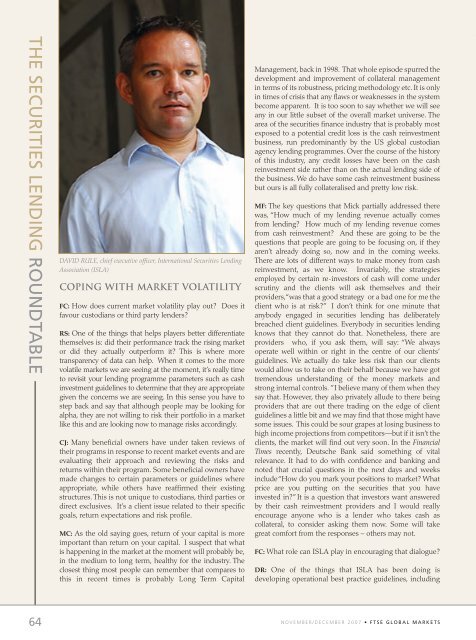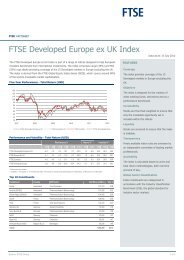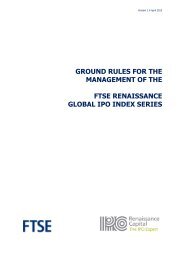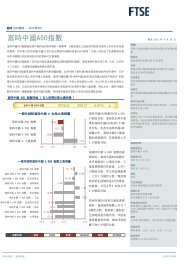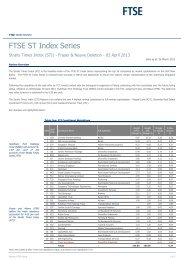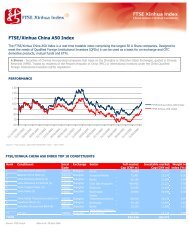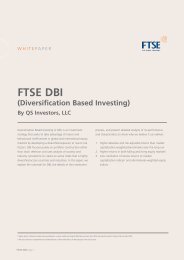Section 2 - FTSE
Section 2 - FTSE
Section 2 - FTSE
Create successful ePaper yourself
Turn your PDF publications into a flip-book with our unique Google optimized e-Paper software.
THE SECURITIES LENDING ROUNDTABLE<br />
64<br />
DAVID RULE, chief executive officer, International Securities Lending<br />
Association (ISLA)<br />
COPING WITH MARKET VOLATILITY<br />
FC: How does current market volatility play out? Does it<br />
favour custodians or third party lenders?<br />
RS: One of the things that helps players better differentiate<br />
themselves is: did their performance track the rising market<br />
or did they actually outperform it? This is where more<br />
transparency of data can help. When it comes to the more<br />
volatile markets we are seeing at the moment, it’s really time<br />
to revisit your lending programme parameters such as cash<br />
investment guidelines to determine that they are appropriate<br />
given the concerns we are seeing. In this sense you have to<br />
step back and say that although people may be looking for<br />
alpha, they are not willing to risk their portfolio in a market<br />
like this and are looking now to manage risks accordingly.<br />
CJ: Many beneficial owners have under taken reviews of<br />
their programs in response to recent market events and are<br />
evaluating their approach and reviewing the risks and<br />
returns within their program. Some beneficial owners have<br />
made changes to certain parameters or guidelines where<br />
appropriate, while others have reaffirmed their existing<br />
structures. This is not unique to custodians, third parties or<br />
direct exclusives. It’s a client issue related to their specific<br />
goals, return expectations and risk profile.<br />
MC: As the old saying goes, return of your capital is more<br />
important than return on your capital. I suspect that what<br />
is happening in the market at the moment will probably be,<br />
in the medium to long term, healthy for the industry. The<br />
closest thing most people can remember that compares to<br />
this in recent times is probably Long Term Capital<br />
Management, back in 1998. That whole episode spurred the<br />
development and improvement of collateral management<br />
in terms of its robustness, pricing methodology etc. It is only<br />
in times of crisis that any flaws or weaknesses in the system<br />
become apparent. It is too soon to say whether we will see<br />
any in our little subset of the overall market universe. The<br />
area of the securities finance industry that is probably most<br />
exposed to a potential credit loss is the cash reinvestment<br />
business, run predominantly by the US global custodian<br />
agency lending programmes. Over the course of the history<br />
of this industry, any credit losses have been on the cash<br />
reinvestment side rather than on the actual lending side of<br />
the business. We do have some cash reinvestment business<br />
but ours is all fully collateralised and pretty low risk.<br />
MF: The key questions that Mick partially addressed there<br />
was, “How much of my lending revenue actually comes<br />
from lending? How much of my lending revenue comes<br />
from cash reinvestment? And these are going to be the<br />
questions that people are going to be focusing on, if they<br />
aren’t already doing so, now and in the coming weeks.<br />
There are lots of different ways to make money from cash<br />
reinvestment, as we know. Invariably, the strategies<br />
employed by certain re-investors of cash will come under<br />
scrutiny and the clients will ask themselves and their<br />
providers,“was that a good strategy or a bad one for me the<br />
client who is at risk?” I don’t think for one minute that<br />
anybody engaged in securities lending has deliberately<br />
breached client guidelines. Everybody in securities lending<br />
knows that they cannot do that. Nonetheless, there are<br />
providers who, if you ask them, will say: “We always<br />
operate well within or right in the centre of our clients’<br />
guidelines. We actually do take less risk than our clients<br />
would allow us to take on their behalf because we have got<br />
tremendous understanding of the money markets and<br />
strong internal controls. ”I believe many of them when they<br />
say that. However, they also privately allude to there being<br />
providers that are out there trading on the edge of client<br />
guidelines a little bit and we may find that those might have<br />
some issues. This could be sour grapes at losing business to<br />
high income projections from competitors—but if it isn’t the<br />
clients, the market will find out very soon. In the Financial<br />
Times recently, Deutsche Bank said something of vital<br />
relevance. It had to do with confidence and banking and<br />
noted that crucial questions in the next days and weeks<br />
include “How do you mark your positions to market? What<br />
price are you putting on the securities that you have<br />
invested in?”It is a question that investors want answered<br />
by their cash reinvestment providers and I would really<br />
encourage anyone who is a lender who takes cash as<br />
collateral, to consider asking them now. Some will take<br />
great comfort from the responses – others may not.<br />
FC: What role can ISLA play in encouraging that dialogue?<br />
DR: One of the things that ISLA has been doing is<br />
developing operational best practice guidelines, including<br />
NOVEMBER/DECEMBER 2007 • <strong>FTSE</strong> GLOBAL MARKETS


